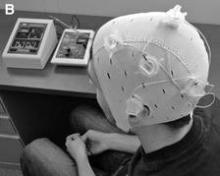Transcranial direct current stimulation delivered focally to the left primary motor cortex of patients with fibromyalgia significantly reduced perceived pain compared with sham stimulation in a proof-of-principle pilot trial.
The reduction in pain levels continued at least 30 minutes after a single, 20-minute session of transcranial direct current stimulation (tDCS) of the left primary motor cortex (M1 area), supporting "the theory that tDCS-induced modulatory effects on pain-related neural circuitry are dependent on modulation of M1 activity," noted the trial investigators, led by Dr. Mauricio F. Villamar of Spaulding Rehabilitation Hospital and Massachusetts General Hospital, both in Boston.
The ability of tDCS and repetitive transcranial magnetic stimulation (rTMS) to modify the excitability of cortical neural circuits, particularly the primary motor cortex (M1), gives them the potential to target one of the pathophysiological mechanisms of fibromyalgia, "where pain can be characterized by a lack of inhibitory control over somatosensory processing," said Dr. Villamar and his associates.
The researchers noted that although tDCS may have advantages over rTMS in its portability, ease of use, and low cost, the relatively large electrode pads used for tDCS in earlier studies of chronic pain disorders affect diffuse areas of the brain and could potentially be improved to provide larger effect sizes and reduce the likelihood of side effects by decreasing stimulation to adjacent regions. The investigators created a method for delivering tDCS with increased focality, called high-definition tDCS, through the use of four small electrode pads configured in a ring around a central electrode to increase the focality of stimulation. The central electrode could be switched between anode and cathode states.
All 18 trial participants (15 were women) and the physiatrist who performed the nociception assessments were blind to the type of stimulation. The participants all had fibromyalgia diagnoses that met the 2010 American College of Rheumatology Preliminary Diagnostic Criteria. They had a mean age of 50 years and had been diagnosed with fibromyalgia for a mean of nearly 11 years before enrollment (J. Pain 2013 Feb. 18 [doi: 10.1016/j.jpain.2012.12.007]).
The trial had a crossover design in which the 18 patients underwent either real stimulation (where the central electrode functioned as either an anode or a cathode) or sham stimulation on three separate clinic visits, with the order of stimulation counterbalanced and randomly assigned for each individual. There was also a baseline and a final visit that did not involve treatment.
At each session, participants received direct current that was gradually increased over 30 seconds up to 2 mA. Actively treated patients received stimulation for 20 minutes, while the current was shut down after the initial 30 seconds in sham-treated patients. The authors noted that the 30-second duration "has been reported to be a reliable method for blinding participants in conventional tDCS trials, which induces no effects on cortical excitability."
Pain scores on a visual numerical scale of 0-10 with 0.5-point increments showed declines from baseline to immediately after stimulation to 30 minutes after stimulation for all three treatments (sham and anodal and cathodal stimulation). However, only cathodal HD-tDCS gave significant improvement over sham treatment immediately after stimulation. Both cathodal and anodal HD-tDCS resulted in significant pain reduction 30 minutes after the end of stimulation. In the sham stimulation group, mean pain scores dropped from 5.09 at baseline to 4.59 immediately after stimulation to 4.41 30 minutes after. For anodal stimulation, mean pain scores dropped from 5.47 to 4.79 to 4.07, respectively. For cathodal stimulation, the scores declined from 5.03 to 3.89 to 3.65.
The standard deviation in mean pain scores in all groups ranged from a little less than 2 points to a little more than 2 points. "Although the changes in overall perceived pain showed a relatively large variability, as evidenced by the standard deviation values, this goes in accordance with the large variability in baseline pain levels among participants in our trial," the investigators wrote.
Only anodal stimulation led to a significant increase in the secondary outcome of Semmes-Weinstein monofilament mechanical detection threshold on both sides of the body, compared with sham.
As expected, other secondary measurements did not change significantly in the three groups, including visual numerical score for anxiety, quality of life, Beck Depression Inventory-II score, Semmes-Weinstein monofilament testing for pain thresholds, pain pressure thresholds, and diffuse noxious inhibitory control testing.
No patients reported any unexpected adverse events.
Soterix Medical, the manufacturer of the HD-tDCS device, is now recruiting participants with fibromyalgia for another multicenter trial that will test the magnitude and durability of effects with repeated HD-tDCS sessions.


